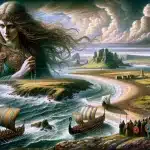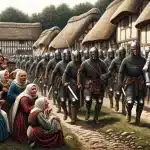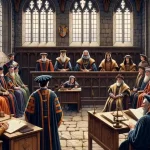Last Updated on 21/05/2025 by Alex Hamlyn
Table of Contents
While beliefs in folk magic and maleficium had always simmered, the mid-17th century, roughly spanning from 1645 to 1647, saw an explosion of fear and persecution that remains utterly captivating – and, frankly, quite disturbing – to this day.
The Peak of Paranoia: Britain’s Witch Hunt Frenzy
To understand why this period became so fevered, we have to rewind slightly. The legal groundwork for widespread witch trials was laid incrementally. Early on, the 1542 Witchcraft Act under Henry VIII, though short-lived, marked a significant shift by making witchcraft a felony, moving its prosecution from the church to secular courts. This was solidified by the 1563 Act under Elizabeth I, and then intensified by the infamous 1604 Witchcraft Act of James I. James, a monarch obsessed with the dark arts (he’d even written his own treatise, Daemonologie), firmly believed in the Devil’s tangible presence and the reality of his human agents. This legislation, critically, made “invoking evil spirits” a capital offence, setting the legal stage for countless trials and executions.
The Spark of Madness: Witches When, Where, and Why?
While accusations had been occurring for decades, the true peak, what some historians refer to as the “Great English Witch Hunt,” was ignited by the social and political inferno of the English Civil War (1642-1651). This period of unprecedented upheaval utterly shattered traditional authority and communal stability. With the King at war with Parliament, central control fractured, leaving local communities adrift in a sea of fear and uncertainty. This power vacuum, combined with widespread economic hardship – disrupted trade, poor harvests, and the sheer cost of war – created a breeding ground for suspicion and scapegoating. When misfortune struck, whether it was a blight on crops or a sudden illness, the devil, through his alleged human servants, offered a ready explanation.
Religious fervour, too, played a massive role. Puritan ideology, which gained significant traction during the Civil War, emphasized a stark, dualistic worldview of good versus evil, God versus the Devil. This heightened awareness of Satan’s perceived omnipresence amplified fears of witchcraft, seen as a direct affront to God and a sign of moral decay.
The Unholy Craft: Defining a Witch
So, how was a witch defined in this terrifying era? Generally, a witch was believed to be an individual – overwhelmingly female, often elderly, poor, and vulnerable – who had entered into a pact with the Devil. This pact granted them malefic powers, which they then used to cause harm: blighting crops, causing illness, killing livestock, or even bringing about death. These were not simply practitioners of folk magic, but agents of Satan, often identified by so-called “witch’s marks” (any blemish or mole) or the presence of “familiars” – demonic animal companions like cats, dogs, or even toads, who suckled on the witch’s blood. The mere accusation, often stemming from long-held community feuds or suspicions, could be enough to trigger a trial.
Famous (or Infamous) Names and Events
While Scotland experienced even more intense witch hunts, England had its own infamous episodes. The Pendle Witch Trials of 1612 in Lancashire are early examples of high-profile cases, but the real explosion came with figures like Matthew Hopkins, the self-proclaimed “Witchfinder General,” and his associate John Stearne. Operating primarily in East Anglia between 1645 and 1647, Hopkins exploited the chaos of the Civil War, traveling from village to village, offering his services for a fee. He claimed divine authority and used insidious methods, including sleep deprivation, pricking for the Devil’s mark (often with a retractable blade), and the infamous “swimming test” – where the accused, if they floated, were deemed witches (as water, a pure element, would reject them). Hundreds were accused and executed under his influence, cementing his place as one of the most terrifying figures of the period. The sheer irrationality of these trials is perhaps best, albeit humorously, encapsulated by the classic Monty Python and the Holy Grail sketch, where a “witch” is identified by whether she weighs the same as a duck – a brilliant satire of the convoluted and deadly logic employed during these dark times.
The Aftermath of British Witch Hunts
The peak of the witch hunts was intense but relatively short-lived. By the late 1640s, skepticism began to grow. The sheer volume of accusations, the questionable methods of witchfinders like Hopkins, and the eventual reassertion of legal authority (as the Civil War concluded) led to a decline in convictions. Judges became more rigorous in demanding proof, and the scientific revolution, fostering a more rational worldview, began to chip away at the superstitious foundations of the accusations.
The last execution for witchcraft in England is generally considered to be that of Janet Horne in Scotland in 1727, and in England, Jane Wenham in 1712, though she was pardoned. Crucially, the Witchcraft Act of 1736 finally repealed the Elizabethan and Jacobean laws, replacing them with legislation that punished those who pretended to have magical powers – effectively reclassifying them as con artists or vagrants. While popular belief in magic and the uncanny certainly lingered in rural communities for many years, the legal persecution of witches in Britain had finally come to an end. It’s a sobering reminder of how easily fear, political instability, and entrenched beliefs can tragically converge.
Read more in this series
Witchcraft in Britain
An Introduction
Witches in Roman Britain
(1st-5th century)
Viking Britain and Witchcraft
(8th-11th century)
Medieval Britain and Witchcraft
(5th century onward)
Plantagenet and High Medieval Britain (12th-15th century)
17th Century: The Peak of Witch Hunts in Britain
Modern Britain And Witchcraft – As Strange As Ever
Witchcraft and the Celts
(Pre – AD43)
Witches in Saxon Britain
(5th-11th century)
Norman Britain and Witchcraft
(11th-12th century)
Early Modern Period and Restoration (15th-18th century)
Victorian Britain and Witchcraft
(19th-20th century)
Famous Witches in British History
(Plus one Witch Hunter)



